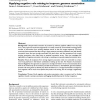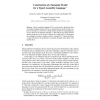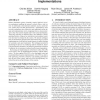283 search results - page 51 / 57 » Software Inspections We Can Trust |
BMCBI
2007
13 years 7 months ago
2007
Background: Unsupervised annotation of proteins by software pipelines suffers from very high error rates. Spurious functional assignments are usually caused by unwarranted homolog...
VMCAI
2004
Springer
14 years 23 days ago
2004
Springer
Typed Assembly Languages (TALs) can be used to validate the safety of assembly-language programs. However, typing rules are usually trusted as axioms. In this paper, we show how to...
FLAIRS
2007
13 years 9 months ago
2007
As personal assistant software matures and assumes more autonomous control of its users’ activities, it becomes more critical that this software can explain its task processing....
PLDI
2005
ACM
14 years 29 days ago
2005
ACM
Robust and powerful software instrumentation tools are essential for program analysis tasks such as profiling, performance evaluation, and bug detection. To meet this need, we ha...
SIGSOFT
2010
ACM
13 years 5 months ago
2010
ACM
Robust distributed systems commonly employ high-level recovery mechanisms enabling the system to recover from a wide variety of problematic environmental conditions such as node f...



